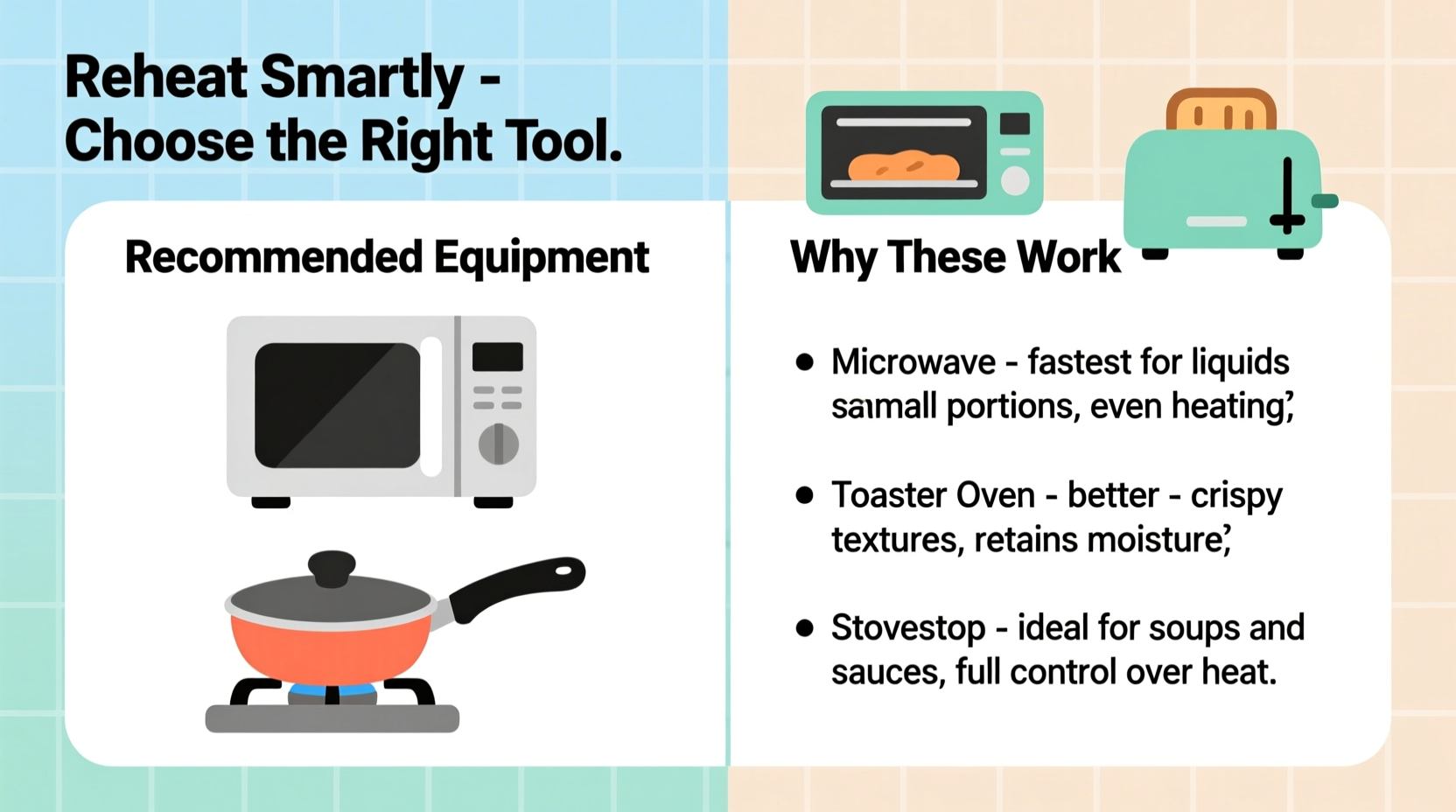Reheating leftovers properly preserves flavor, texture, and most importantly, safety. Many home cooks default to the microwave for convenience, but choosing the right equipment for each food type prevents disappointment and potential health risks. This guide provides evidence-based recommendations so you can consistently revive your leftovers like a professional chef.
Why Equipment Choice Matters for Reheating Food
Improper reheating leads to soggy pizza, rubbery meats, and unevenly heated meals. Food scientists have demonstrated that different heating methods affect moisture retention, texture, and flavor compounds in distinct ways. The FDA Food Code specifies that all cooked potentially hazardous foods must be reheated to 165°F within two hours to prevent bacterial growth.
| Food Type | Best Reheating Method | Target Temperature | Time Required |
|---|---|---|---|
| Pizza, Fried Foods | Air Fryer or Toaster Oven | 350-375°F (175-190°C) | 3-5 minutes |
| Casseroles, Moist Dishes | Conventional Oven | 325°F (163°C) | 15-25 minutes |
| Soups, Sauces | Stovetop | 165°F (74°C) | 3-7 minutes |
| Rice, Grains | Steamer or Microwave with Water | 165°F (74°C) | 2-4 minutes |
Equipment Breakdown: When to Use What
Air Fryer: The Crispness Champion
Air fryers excel at restoring crisp textures without drying out food. According to research published in the Journal of Food Engineering, the rapid hot air circulation in air fryers creates a Maillard reaction similar to deep frying but with significantly less oil absorption. This makes them ideal for:
- Pizza (3-4 minutes at 350°F)
- Fried chicken and french fries
- Spring rolls and other battered foods
Pro tip: Lightly spray food with oil before reheating to enhance crispness without making it greasy.
Conventional Oven and Toaster Oven: Even Heating Experts
For larger portions or delicate foods that need gentle, even heating, conventional ovens work best. The USDA Food Safety and Inspection Service recommends oven reheating for casseroles and roasted meats because it heats food more evenly than microwaves. Set your oven to 325°F and cover food with foil to retain moisture.
Microwave: The Speed Specialist (Used Correctly)
While often criticized, microwaves can produce excellent results when used properly. The key is understanding how to manage moisture. Place a damp paper towel over foods like pasta or vegetables to create steam that prevents drying. For multiple portions, arrange food in a circle leaving the center empty for more even heating. Always use microwave-safe containers and stir or rotate food halfway through reheating.
Stovetop Methods: Precision Control
For soups, sauces, and stir-fries, the stovetop offers unmatched control. The FDA recommends reheating liquids to a rolling boil for one minute to ensure safety. For delicate proteins like fish, use a double boiler method with gentle heat to prevent overcooking.
Food Safety: Non-Negotiable Guidelines
Regardless of your reheating method, follow these critical safety practices from the USDA:
- Refrigerate leftovers within 2 hours of cooking (1 hour if room temperature exceeds 90°F)
- Store in shallow containers no deeper than 2 inches for rapid cooling
- Always reheat to 165°F internal temperature measured with a food thermometer
- Discard leftovers after 3-4 days in the refrigerator
Improperly reheated rice poses particular risks, as Bacillus cereus spores can survive initial cooking and multiply during cooling. The UK Food Standards Agency specifically recommends cooling rice quickly after cooking and reheating only once to minimize this risk.
Special Considerations for Common Foods
Reheating Pizza Perfectly
Forget soggy microwave pizza. For optimal results, use a skillet method: place pizza in a cold non-stick skillet, cover, and heat on medium-low for 5-7 minutes. The bottom becomes crispy while the cheese melts gently from trapped steam. This technique, validated by food scientists at America's Test Kitchen, creates results comparable to a professional pizza oven.
Saving Leftover Rice Without Drying Out
Rice loses moisture quickly when reheated. The Japanese method involves sprinkling 1-2 teaspoons of water per cup of rice, covering tightly, and microwaving for 1 minute. Let it rest for 2 minutes before fluffing. This technique maintains the ideal moisture content of 60-65% that food scientists identify as crucial for palatable reheated rice.
Reviving Fried Foods Without Sogginess
Fried foods become soggy when moisture turns to steam and softens the crust. The solution? Reheat in an air fryer at 375°F for 3-4 minutes. Research from the Culinary Institute of America shows this method evaporates surface moisture while reheating the interior, restoring crispness without additional oil.

Troubleshooting Common Reheating Problems
Preventing Sogginess
Sogginess occurs when steam gets trapped. Solution: leave food uncovered during reheating and use equipment that promotes evaporation (air fryer, oven). For microwave use, place a paper towel underneath to absorb excess moisture.
Avoiding Dryness
Dryness happens when moisture evaporates too quickly. Add a splash of broth, water, or sauce before reheating. Cover casseroles and meats with foil during oven reheating to trap moisture.
Ensuring Even Heating
Stir or rotate food halfway through reheating. Arrange food in a ring shape rather than a pile. For large portions, reheat at a lower temperature for longer to allow heat to penetrate evenly.
When Not to Reheat Certain Foods
Some foods simply don't reheat well or pose safety concerns:
- Eggs and egg dishes (risk of salmonella if not reheated properly)
- Seafood (easily overcooked and develops off-flavors)
- Leafy greens (become limp and unappetizing)
- Potato dishes (risk of botulism if improperly stored)
The European Food Safety Authority specifically warns against reheating cooked potatoes that have been left at room temperature, as this creates ideal conditions for botulism bacteria.











 浙公网安备
33010002000092号
浙公网安备
33010002000092号 浙B2-20120091-4
浙B2-20120091-4